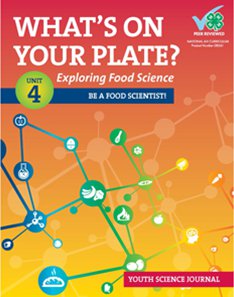The What’s On Your Plate series comes from the National 4-H Council. See my general overview of 4-H guides here. What’s On Your Plate consists of four units, each with their own Youth Science Journal for the student and facilitator guide for the parent or teacher. The entire series can be used with students in grades five through twelve. The four units are:
- Unit 1: The Secret of Baking
- Unit 2: The Power of Protein Chemistry
- Unit 3: The Inner Mysteries of Fruits and Vegetables
- Unit 4: Be a Food Scientist!
The lessons introduce students to food science with experiments, activities, research, thought-provoking questions, research, and writing. Chemistry, biology, and physics all come into play as students learn about the creation of gluten in breadmaking, yeast and other leavening agents, the use of eggs in food, turning milk into cheese, preparing fruits and vegetables, crystallization in candy making, and other topics.
You can use the units in any order you wish although the third and fourth units are slightly more difficult than the first two units. The units serve best as supplements to your core science program, but you could combine one or more of these units with other 4-H courses to create a complete science course.
Each book (or unit) is divided into three topical lessons. You might do a complete lesson in a lengthy class session, but I think it more likely that you will use class or one-on-one time for the actual activity and discussion then have students complete other work on their own. Your class sessions need to be long enough to allow for some of the lengthy activities such as making pretzels with quick-rising yeast or creating a chocolate soufflé. Everything can be done in an ordinary kitchen with typical ingredients and supplies.
Many of these activities will be more fun done with two or more students. The Facilitator Guides suggest groups of eight to twelve. While smaller groups of just a few students give each student more hands-on experience and probably fit better into most kitchen areas, larger groups allow for a broader exchange of ideas in the discussions.
For each unit you will need a Facilitator Guide and a Youth Science Journal for each student.
A web page at the 4-H site http://www.4-H.org/curriculum/foodsci has additional materials such as videos, handouts, podcasts, and links to other websites. For example, students can learn how to create a Nutrition Facts label by entering their recipe into a recipe analysis program on a free website or they can watch a video showing how carrots are harvested and processed. The additional materials are optional, but there are lots of interesting things to check out there.
I expect that What’s On Your Plate? should appeal to most students because everyone has an interest in food, especially when they get to sample their products. In addition, they learn some serious science that will probably come in handy as they move on to biology, chemistry, and physics classes.









